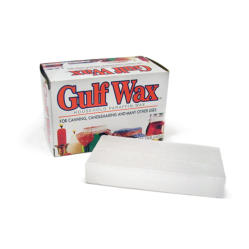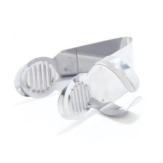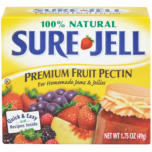
For over twenty years my family has gone out to a pick your own strawberry farm every May to gather enough
strawberries to make our own strawberry jam. It is a lot of work but it is worth it since we make enough delicious jam
to last all year long. Once you have home made jam in the
cupboard then store bought jam’s taste and color will be
pale in comparison. My daughter says that the color of
store bought jam is “gray.”
Ingredients:
1 box Sure-Jell Fruit Pectin (see photo)
3-4 quarts (approximately) fresh strawberries
(not overripe!) to make 5 cups
crushed fresh strawberries
7 cups sugar
1 tablespoon butter or more, which prevents the jam
from
foaming during boiling
Several clean jam jars for storage
Canning wax/paraffin for sealing the jars (see photo)
Strawberry huller, for easy stemming (see photo below)
2025 Update: This method works great with raspberries too. You need about 42 ounces (7 x 6 ounce
packages) of raspberries to make the required 5 cups of smashed berries for this recipe.
My mother and grandmother made jam this same way, so this recipe has a special
meaning for me. I added the important step about the butter, though!
Check the expiration date on the box of pectin to see if the expiration date is next year.
That way you are sure to have the freshest most basic ingredient for jam making. Old pectin
does not set jam well.
You must also measure ingredient quantities exactly to avoid setting troubles. Jam that is
too runny or too firm cannot be saved (there are “remake” directions available but I don’t trust
them). Don’t be tempted to use less sugar or sugar substitutes because that will cause setting
problems for the jam for sure. Also, do not try to double or triple the recipe because I’ve read that
does not work well. I have never tried to double this recipe because I am afraid to – it takes to
much work to prepare all those strawberries and I will not risk ruining any of my batches. There
are low sugar and no-sugar varieties of pectin but still I am afraid they will not turn out for me and
my strawberries and my labor will go to waste.
First, the fresh strawberries need to be rinsed and hulled. I dip
each strawberry in a bowl of water and rub it quickly with my fingers to
remove any dirt. I change the water in the bowl every few minutes and
it’s important to place the clean strawberries in a colander to drain so
that no extra water is added to the jam mixture. Then I take out the
green leafy top and internal stem of each strawberry with my strawberry
huller (see photo). The huller (see photo) makes it easy to remove just
the leaves and stem and wastes no fruit like you do when you just cut
off the whole top of the strawberry. My huller has a bracket for your
thumb to hold tight while you plunge the two prongs of the huller into the top of the strawberry
and pluck out the stem and leaves in one motion.
Take one or two cups at a time of cleaned and hulled strawberries and crush them with a
potato masher in a large shallow bowl. Do not use a food processor because it will puree the
berries quickly, and we want pieces of fruit floating around in the finished jam. When you get five
cups worth, put it all in a very large (8-10 quart or more) sauce pot and add all the Sure-Jell
pectin from the box. It’s good to have a really big pot so that you don’t get splattered - this is a
messy job! Also add the butter since that will reduce or eliminate the unattractive foam that may
form and spoil the look of your finished jam. The foam will not subside on its own when the jam cools.
Get ready to make a mess. The fruit’s juice will spatter and it will stain Formica and some other countertops, so
lay out some dishtowels to protect the counter and wear old clothes or an apron. Take a block of the paraffin out of its
box and put it in an old small frying pan that you are willing to throw away, because cleaning that pan will be trouble.
Or just use that same pan (and the spoon you will use with it) every year. Put the pan on very low heat, just enough
to liquefy the paraffin and keep it in liquid form ready to use.
Prepare your storage jars so they are ready to go. You can use fancy jam jars with multi-part lids and boil them
first to sterilize them, etc. But I just use leftover food jars that have been through my dishwasher with a good hot
rinse. I like to take a cookie sheet lined with foil and place the open jars on it so that the cleanup of spills and drips
will be a snap.
Now bring the strawberry and pectin mixture to a full rolling boil on the highest heat that you have on your stove.
A full rolling boil is a furious boiling that keeps on bubbling even when you are stirring it. The bubbles seem to “roll”
on the surface. You must keep stirring almost constantly or else the very high heat will scald the mixture and quickly
cause burned strawberry juice to accumulate on the bottom of the pot and give the whole mixture a burnt taste.
As soon as you get a good rolling boil going, add all of the sugar at one time and quickly, without delay, stir in
the sugar until it is all dissolved. It’s important to stir in the sugar quickly because it will burn on the bottom of the pot
even faster than the red strawberry mixture. Once the sugar is dissolved, keep stirring and get the whole mixture
back up to a full rolling boil.
Okay, here comes the hard part. How long do you boil this mixture? Boil it too long, and the jam will be rock
hard. Too short and the jam will be runny like syrup. This is where most novice jam makers go wrong.
Here’s why: Many recipes say that after the sugar and the strawberries are again up to a rolling boil then you
should boil it just 60 seconds longer and remove the pot from the heat. This just does not work for me because there
are too many variables that I can’t seem to control. First, how much moisture was in those fresh strawberries? (never
use frozen – they have too much moisture gained from the freezing process.) Second, it is easy to misjudge exactly
when the rolling boil has started. Third, how long did it take to bring the mixture up to a boil (both times)? If it took a
long time then your mixture may have spent more time at high heat than mine did. Next, how fresh was that pectin?
Even your height above sea level can affect the cooking and setting of the jam. All these things and more seem to
make it impossible for me to tell you how much time you should boil your strawberry jam.
So here is what I do, as sort of a trial and error method: After the sugar is added and the “full rolling boil” has
been restarted for a minute or so, I put a couple of spoonfuls of jam into a small stainless steel (to conduct the cold
well) bowl and slip it into my freezer to cool. I cut back the heat on the stove for a few minutes and take out the bowl
and tilt it – if the jam runs freely it is not yet done. If it runs like very thick syrup and has skinned over just a bit then it
is ready!
I am sorry that I cannot be more specific, but your kitchen and ingredients may be so different than mine that
you will have to experiment a bit to get the right timing. If you use my trial and error method you might actually never
waste a single batch by over or under-cooking!
2024 Update: After the sugar is in and the mixture returns to a full rolling boil, even when stirred, boil
for another 2 minutes exactly and jam setting will be spot on.
When the jam is done, ladle it while it is still piping hot into each jar taking care to leave ½ inch clearance from
the top for the paraffin. Then add a few spoonfuls of some hot liquid paraffin into each jar to make an effective seal.
Don’t bother with the paraffin for the few jars that you will consume within 3-4 weeks, just put them in the refrigerator.
You can store the paraffin sealed jars in a cool dark cupboard for almost a year. If you are using jam jars with multi-
part lids, follow the directions that came with the jars to seal them properly.
It will take a few hours for the jars to cool, but then get ready to enjoy the best and freshest strawberry jam you
ever tasted!

Home Made Strawberry Jam
Home | Indian Recipes | Thai Recipes | Main Dishes | Desserts | Leave a Comment | Recipes by Email | About
Copyright © Suzanne’s Recipe File | Privacy Policy

►Home-All
Recipes
►Desserts
►Chocolate Pixie
Cookies
►Chuck’s Hot
Fudge
►Maddy’s Peach
Crumble
►Blueberry Skillet
Cobbler
►Molasses
Cookies
►Oatmeal
Cookies
►Peanut Butter
Cookies
►Sugar Cookies
►Carrot Cake
►Strawberry Cake
►Gingerbread
Boys
►Toll House
Cookies
►Apple Pie
►Cheesecake
►Mincemeat Pie
►Watermelon &
Yogurt
►Pecan Pie
►Pumpkin Pie
►Homemade Pie
Crust
►Pecan Squares
►Nut and Seed
Tart
►Banana Bread
►Bread Pudding
►Rice Pudding
►Strawberry
Shortcake
►Strawberry Jam
►Chocolate
Frosting
►Birthday Cake
►Chocolate
Rasberry Frosting
►Cream Cheese
Frosting
►Coffee Cake
►Whipped Cream
►Rice Krispies
Treats


- Chocolate Pixie Cookies
- Watermelon, Yogurt & Rosemary
- Maddy's Peach Cobbler
- Blueberry Cobbler
- Chuck's Hot Fudge
- Molasses Drop Cookies
- Oatmeal Cookies
- Carrot Cake
- Neapolitan Strawberry Cake
- Peanut Butter Cookies
- Sugar Cookies
- Toll House Cookies
- Gingerbread Boys
- Apple Pie
- Mincemeat Pie
- Pecan Pie
- Pumpkin Pie
- Pecan Squares
- Caramelized Nut Tart
- Banana Bread
- Rice Pudding
- Bread Pudding
- Chocolate Frosting
- Chocolate Rasberry Frosting
- Cream Cheese Frosting
- Coffee Cake
- Cheesecake - No Bake
- Whipped Cream
- Strawberry Shortcake
- Strawberry Jam
- Rice Krispies Treats












